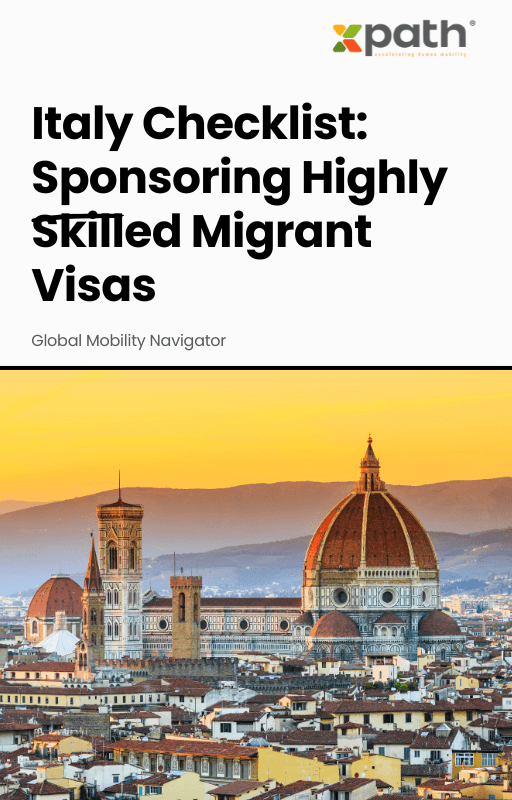Italy Checklist: Sponsoring Highly Skilled Migrant Visas
Grab a copy of a guide to international employee relocation
View E-bookThe workplace is going global at warp speed. In 2023, Deloitte reported that over 80% of organizations ramped up international assignments and remote work options to fill critical talent gaps and support business growth. But let’s be honest: juggling cross-border tax, compliance, housing, and partner support isn’t child’s play—it’s a high-stakes balancing act. Companies now face a stark reality: Without investing in robust global mobility tech, even the world’s best HR teams risk drowning in logistical chaos.
Forget dusty binders and patchwork emails. Today’s game-changing platforms, like xpath.global, pull together assignment management, document automation, cost projection, and vendor coordination. Think of them as your high-octane control tower—allowing HR to visualize all relocation journeys with pinpoint accuracy.
According to Mercer’s 2024 Global Talent Trends study, over 70% of multinational HR leaders credited automation and data-driven insights as the secret ingredients behind their improved assignment satisfaction rates, cost savings, and compliance records. And it’s not just the giants—companies of all shapes and sizes are jumping onboard.
Data is the new passport in HR. Consider this: A recent EY survey found that a whopping 68% of HR directors said their mobility programs were ‘highly inefficient’ prior to adopting modern tech solutions. After implementation, these organizations reported:
– Assignment processing times slashed by 45%
– Compliance incidents cut by 60%
– Cost estimation accuracy up by 50%
Want proof? Just look at how the fintech firm TransferWise (now Wise) scaled its operations to 17 countries in under 24 months after deploying automated mobility management. People ops teams could finally breathe, focusing on talent strategy—and not endless paperwork.
But there’s a catch. As borders blur, complexity skyrockets. HR doesn’t just handle visas; they wrangle global payroll, relocation tax implications, family support, duty of care, and compliance in a spiderweb of ever-changing regulations. And let’s not forget about remote work, where employees may sit in Paris but get paid in pounds. Navigating this labyrinth demands precision and up-to-the-minute information.
The 2023 Worldwide ERC State of Mobility survey exposed a sobering stat: Over half of companies fumbled their first global expansion attempt due to compliance pitfalls or slow-moving relocation support. The solution? Centralized, AI-driven tech that’s as flexible as the workforce it supports—think automated alerts, real-time policy updates, and digital cost tracking all in one place.
Let’s zone in on a real-world game changer: xpath.global. When a European consulting giant expanded into Latin America, they faced a nightmare: mismatched policies, visa confusion, and overwhelmed HR. By switching to xpath.global’s all-in-one platform, they gained:
– One dashboard for all assignments across 30 countries
– Seamless integration with preferred vendors for housing, schooling, and immigration
– Automated reminders for renewals and compliance requirements
– Interactive analytics for real-time decision-making
The result? HR satisfaction soared, errors dropped, and talent retention for relocated employees shot up by 20% in just the first year.
The future is already knocking. Expect to see even smarter use of AI—predicting assignment success based on previous patterns, matching talent to international projects, and customizing experiences to individual employee needs. Mobile-first dashboards, on-demand compliance updates, and third-party integration are quickly becoming the new must-haves, not nice-to-haves.
Companies embracing these innovations won’t just avoid costly missteps—they’ll position themselves as employers of choice in a fiercely competitive, borderless talent market.
HR professionals, here’s the bottom line: Global mobility is no longer an exclusive club or a back-office headache. It’s the fuel that powers growth and global ambition. If your assignment management still feels like rolling a boulder uphill, consider this your wake-up call. Explore dynamic global mobility solutions like xpath.global to automate, simplify, and empower your HR teams—because staying competitive means moving at the speed of business.
What is a global mobility solution?
A global mobility solution is technology or a suite of services that helps companies manage employee relocations, cross-border compliance, assignment costs, and other HR tasks required for an international workforce.
Why are global mobility solutions necessary?
With more companies operating across borders, manual processes can no longer keep pace. Automated solutions reduce errors, ensure compliance, and boost employee satisfaction, freeing HR to focus on strategic priorities.
How does xpath.global help HR teams?
xpath.global offers an integrated platform for managing assignments across countries, automating compliance, tracking costs, communicating with vendors, and providing real-time analytics—all in one place.
What trends should we expect in global mobility tech?
Look for rising use of AI, predictive analytics, mobile access, real-time compliance alerts, and flexible integration with other HR tools and vendors.
Is global mobility tech only for big multinationals?
Absolutely not. Even startups or fast-growing mid-sized companies can benefit—modern platforms like xpath.global are tailored for scalability and ease of use, regardless of organization size.
Ready to transform your mobility program? Explore xpath.global’s solutions.

Italy Checklist: Sponsoring Highly Skilled Migrant Visas
Grab a copy of a guide to international employee relocation
View E-book